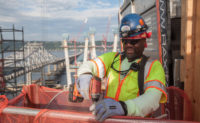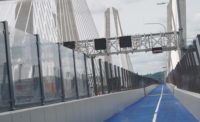The consortium that constructed the Mario M. Cuomo Bridge across the Hudson River in New York has filed a new lawsuit seeking hundreds of millions of dollars it says it is owed for the project. In the suit, filed Feb. 8 in the New York State Court of Claims, the team says it is owed more than $923 million in unapproved and disputed changes and delays by the New York State Thruway Authority, and another $30.1 million for changes that were approved.
The outcome could determine the way future contractors weigh their risks in doing design-build in New York State.
In the breach of contract suit by the Fluor Corp.-led consortium that built the bridge, which opened for service in 2018, the authority stands accused of meddling with design long after it was to have ended, violating the collaborative spirit of the contract and refusing or dragging its feet in responding to requests for price adjustments and delays caused by the authority.
The consortium team members also included American Bridge Co., Granite Construction Northeast Inc. and Traylor Bros. Inc.
Sam Choy, project executive for the consortium, said in a Feb. 1 letter to the authority that the consortium member companies appealed to NY Gov. Andrew Cuomo for a meeting about the payment matters but that its correspondence went unanswered. In the letter, addressed to authority project director Jamey Barbas, Choy portrays the agency as passively aggressive in leaving a series of dispute submissions under review and undecided for months and years.
The alleged stall tactics extended to claims consultants engaged by the authority last year that the consortium says were in its view "aimed at continuing to delay resolution."
A big source of trouble in the consortium's eyes was the thruway authority's micromanaging deep into the design process.
The authority's uncooperative attitude allegedly extended down to the naming of candidates for an advisory committee to assist with dispute resolution.
Its officials could not immediately be reached for comment or reply to the allegations in the lawsuit.
In response to the lawsuit, the authority said that it doesn't comment on pending litigation as a rule. But the authority said in a statement that it is committed to protecting toll payers, making sure contractors perform and that New Yorkers enjoy a bridge that will last for 100 years with low maintenance costs and without unjustified cost increases.
An early settlement of the dispute is unlikely, since Gov. Cuomo, who named the bridge for his father, former Gov. Mario Cuomo, has described the new structure as completed on time and on budget. In public comments, Cuomo and other transportation officials have defined design-build as an effective risk-transfer tool.
The authority, in its statement to ENR, repeated that the bridge was done on time and on budget and added "that all valid invoices have been paid in full and we continue to review the claim through the agreed upon process." The authority said the it agreed to amend the dispute resolution process to allow earlier claims submission is "proceeding in accordance" with the process.
For its work, the consortium has been paid $3.47 billion. It previously failed in a prior lawsuit to have the thruway authority turn over additional records to the consortium. Shortly after that decision, the consortium members sued a bridge demolition consultant on the project, seeking $45 million. That lawsuit alleged that the consultant's errors forced the consortium to resort to explosive demolition for a key bridge truss and section when manual demolition was planned.
The authority's liability, the lawsuit claims, includes a delayed start to the construction. A notice to proceed originally set for Oct.15, 2012 was delayed until Jan.18, 2013.
A major source of trouble in the consortium's eyes was the authority's micromanagement deep into the design process. It allegedly added hundreds of millions of dollars of extra costs for the constructor, the lawsuit claims.
The authority "and its agents regularly performed unnecessary, detailed reviews" of the consortium's design, which "significantly impeded and disrupted the design development process." The design-build contract specifically required the authority to work collaboratively with the constructor, says the consortium, and expedite submittal and review of changes without delaying design and construction and adding to costs.
In the lawsuit, the consortium says the interference and long, drawn-out analysis and delays included a bridge perimeter barrier system, steel pipes, pile caps and the structure's concrete pedestal.
Role of HNTB and HDR
HNTB, the authority's design consultant, repeatedly ignored and substituted its own ideas for those of HDR, the main design consultant to the consortium, the lawsuit states. The interference was a breach of contract, it contends. Making matters worse, during these events the authority allegedly refused to grant the consortium a time extension.
Under a section of its design-build contract, the lawsuit claims, the authority was obligated to work with the consortium cooperatively, "in an equitable fashion," to solve all usual challenges of such a large project.
Compensable delays and changed conditions in its contract, the lawsuit claims, include "authority-caused delays."





Post a comment to this article
Report Abusive Comment